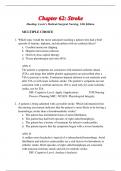Exam (elaborations)
Chapter 62: Stroke |Harding: Lewis’s Medical-Surgical Nursing, 12th Edition
- Course
- Institution
MULTIPLE CHOICE 1. Which topic would the nurse anticipate teaching a patient who had a brief episode of tinnitus, diplopia, and dysarthria with no residual effects? a. Cerebral aneurysm clipping b. Heparin intravenous infusion c. Oral low-dose aspirin therapy d. Tissue plasminogen activator ...
[Show more]



